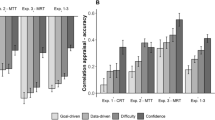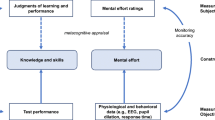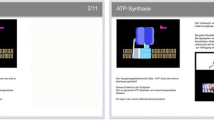Abstract
Subjective cognitive load (CL) rating scales are widely used in educational research. However, there are still some open questions regarding the point of time at which such scales should be applied. Whereas some studies apply rating scales directly after each step or task and use an average of these ratings, others assess CL only once after the whole learning or problem-solving phase. To investigate if these two approaches are comparable indicators of experienced CL, two experiments were conducted, in which 168 and 107 teacher education university students, respectively, worked through a sequence of six problems. CL was assessed by means of subjective ratings of mental effort and perceived task difficulty after each problem and after the whole process. Results showed that the delayed ratings of both effort and difficulty were significantly higher than the average of the six ratings made during problem solving. In addition, the problems we assumed to be of higher complexity seemed to be the best predictors for the delayed ratings. Interestingly, for ratings of affective variables, such as interest and motivation, the delayed rating did not differ from the average of immediate ratings.
Similar content being viewed by others
References
Antonenko, P., & Niederhauser, D. (2010). The influence of leads on cognitive load and learning in a hypertext-assisted learning environment. Computers in Human Behavior, 26, 140–150.
Antonenko, P., Paas, F., Grabner, R., & Van Gog, T. (2010). Using electroencephalography (EEG) to measure cognitive load. Educational Psychology Review, 22, 425–438.
Ayres, P. (2006). Using subjective measures to detect variations of intrinsic load within problems. Learning and Instruction, 16, 389–400.
Bratfisch, O., Borg, G., & Dornic, S. (1972). Perceived item difficulty in three tests of intellectual performance capacity. Stockholm: Institute of Applied Psychology, Report No. 29.
Brünken, R., Plass, J. L., & Leutner, D. (2003). Direct measurement of cognitive load in multimedia learning. Educational Psychologist, 38, 53–61.
Brünken, R., Plass, J. L., & Leutner, D. (2004). Assessment of cognitive load in multimedia learning with dual-task methodology: Auditory load and modality effects. Instructional Science, 32, 115–132.
Chandler, P., & Sweller, J. (1991). Cognitive load theory and the format of instruction. Cognition and Instruction, 8, 293–332.
Chandler, P., & Sweller, J. (1992). The split-attention effect as a factor in the design of instruction. British Journal of Educational Psychology, 62, 233–246.
Chandler, P., & Sweller, J. (1996). Cognitive load while learning to use a computer program. Applied Cognitive Psychology, 10, 1–20.
de Jong, T. (2010). Cognitive load theory, educational research, and instructional design: Some food for thought. Instructional Science, 38, 105–134.
Kalyuga, S., Chandler, P., & Sweller, J. (1999). Managing split-attention and redundancy in multimedia instruction. Applied Cognitive Psychology, 13, 351–371.
Kalyuga, S., Chandler, P., Tuovinen, J., & Sweller, J. (2001). When problem solving is superior to studying worked examples. Journal of Educational Psychology, 93, 579–588.
Kühl, T., Scheiter, K., Gerjets, P., & Edelmann, J. (2011). The influence of text modality on learning with static and dynamic visualizations. Computers in Human Behavior, 27, 29–35.
Kuusela, H., & Paul, P. (2000). A comparison of concurrent and retrospective verbal protocol analysis. American Journal of Psychology, 113, 387–404.
Leutner, D., Leopold, C., & Sumfleth, E. (2009). Cognitive load and science text comprehension: Effects of drawing and mentally imagining text content. Computers in Human Behavior, 25, 284–289.
Logie, R. H. (1995). Visuo-spatial working memory. Hove, UK: Lawrence Erlbaum Associates.
Marcus, N., Cooper, M., & Sweller, J. (1996). Understanding instructions. Journal of Educational Psychology, 88, 49–63.
Opfermann, M. (2008). There’s more to it than instructional design: The role of individual learner characteristics for hypermedia learning. Berlin, Germany: Logos.
Paas, F. (1992). Training strategies for attaining transfer of problem-solving skill in statistics: A cognitive-load approach. Journal of Educational Psychology, 84, 429–434.
Paas, F., Ayres, P., & Pachman, M. (2008). Assessment of cognitive load in multimedia learning: Theory, methods and applications. In D. Robinson & G. Schraw (Eds.), Recent innovations in educational technology that facilitate student learning (pp. 20–36). Charlotte, NC: Information Age Publishing.
Paas, F., Renkl, A., & Sweller, J. (2003a). Cognitive load theory and instructional design: Recent developments. Educational Psychologist, 38, 1–4.
Paas, F., Tuovinen, J., Tabbers, H. K., & Van Gerven, P. W. M. (2003b). Cognitive load measurement as a means to advance cognitive load theory. Educational Psychologist, 38, 63–71.
Paas, F., & van Merriënboer, J. J. G. (1994). Variability of worked examples and transfer of geometrical problem solving skills: A cognitive-load approach. Journal of Educational Psychology, 86, 122–133.
Paas, F., van Merriënboer, J. J. G., & Adam, J. J. (1994). Measurement of cognitive load in instructional research. Perceptual and Motor Skills, 79, 419–430.
Park, B., Moreno, R., Seufert, T., & Brünken, R. (2011). Does cognitive load moderate the seductive details effect? A multimedia study. Computers in Human Behavior, 27, 5–10.
Plass, J. L., Moreno, R., & Brünken, R. (Eds.). (2010). Cognitive load: Theory & application. Cambridge: Cambridge University Press.
Renkl, A., Gruber, H., Weber, S., Lerche, T., & Schweizer, K. (2003). Cognitive Load beim Lernen aus Lösungsbeispielen [Cognitive load of learning from worked-out examples]. Zeitschrift für Pädagogische Psychologie, 17, 93–101.
Rheinberg, F., Vollmeyer, R., & Burns, B. D. (2001). FAM: Ein Fragebogen zur Erfassung aktueller Motivation in Lern- und Leistungssituationen [QCM: A questionnaire to assess current motivation in learning situations]. Diagnostica, 47, 57–66.
Schwamborn, A., Thillmann, H., Opfermann, M., & Leutner, D. (2011). Cognitive load and instructionally supported learning with provided and learner-generated visualizations. Computer in Human Behavior, 27, 89–93.
Seufert, T., & Brünken, R. (2006). Cognitive load and the format of instructional aids for coherence formation. Applied Cognitive Psychology, 20, 321–331.
Sweller, J. (1988). Cognitive load during problem solving: Effects on learning. Cognitive Science, 12, 257–285.
Sweller, J. (1993). Some cognitive processes and their consequences for the organization and presentation of information. Australian Journal of Psychology, 45, 1–8.
Sweller, J. (2010). Element interactivity and intrinsic, extraneous and germane cognitive load. Educational Psychology Review, 22, 123–138.
Sweller, J., Ayres, P., & Kalyuga, S. (2011). Cognitive load theory. New York: Springer.
Sweller, J., van Merriënboer, J. J. G., & Paas, F. (1998). Cognitive architecture and instructional design. Educational Psychology Review, 10, 251–296.
Tabbers, H. K., Martens, R. L., & van Merriënboer, J. J. G. (2004). Multimedia instructions and cognitive load theory: Effects of modality and cueing. British Journal of Educational Psychology, 74, 71–81.
Taylor, K. L., & Dionne, J.-P. (2000). Accessing problem-solving strategy knowledge: The complementary use of concurrent verbal protocols and retrospective debriefing. Journal of Educational Psychology, 92, 413–425.
Van Gerven, P. W. M., Paas, F., van Merriënboer, J. J. G., & Schmidt, H. G. (2004). Memory load and the cognitive pupillary response in aging. Psychophysiology, 41, 167–174.
Van Gog, T., & Jarodzka, H. (2013). Eye tracking as a tool to study and enhance cognitive and metacognitive processes in computer-based learning environments. In R. Azevedo & V. Aleven (Eds.), International handbook of metacognition and learning technologies (pp. 143–156). New York: Springer.
Van Gog, T., Kirschner, F., Kester, L., & Paas, F. (2012). Timing and frequency of mental effort measurement: Evidence in favor of repeated measures. Applied Cognitive Psychology, 26, 833–839.
Van Gog, T., & Paas, F. (2008). Instructional efficiency: Revisiting the original construct in educational research. Educational Psychologist, 43, 16–26.
Van Gog, T., Paas, F., & van Merriënboer, J. J. G. (2006). Effects of process-oriented worked examples on troubleshooting transfer performance. Learning and Instruction, 16, 154–164.
Van Merriënboer, J. J. G., & Sweller, J. (2005). Cognitive load theory and complex learning: Recent developments and future directions. Educational Psychology Review, 17, 147–177.
Author information
Authors and Affiliations
Corresponding author
Appendix
Appendix
Weekday problems (according to order of presentation in Experiment 1)
-
(a)
Suppose today is Tuesday. What day of the week is the day after tomorrow?
-
(b)
Suppose today is Thursday. What day of the week is in three days?
-
(c)
Suppose yesterday was Wednesday. What day of the week was four days before the day before yesterday?
-
(d)
What day was yesterday if the day after the day after tomorrow is three days before Sunday?
-
(e)
Suppose five days after the day before yesterday is Friday. What day of the week is tomorrow?
-
(f)
Suppose last Tuesday was the 2nd day. What day of the week is it in 17 days, if the 8th day is in two days?
Rights and permissions
About this article
Cite this article
Schmeck, A., Opfermann, M., van Gog, T. et al. Measuring cognitive load with subjective rating scales during problem solving: differences between immediate and delayed ratings. Instr Sci 43, 93–114 (2015). https://doi.org/10.1007/s11251-014-9328-3
Received:
Accepted:
Published:
Issue Date:
DOI: https://doi.org/10.1007/s11251-014-9328-3




